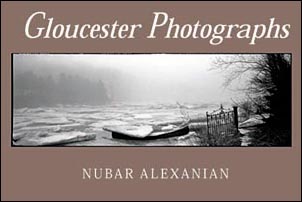|
Introduction
by Joe Garland
The earliest photographic
image of Gloucester of which I'm aware was taken 140 years ago almost
to the day from a second-story window looking west on what was then
Front Street, now Main, right after the blizzard of April 3, 1861. Fascinating.
Spooky.
Clogged with snow and cozily walled between rows of wooden homes and
store fronts with their fancy roof cornices, the narrow way slides a
couple of shadowy horse-drawn sleighs off into the distance. And what
are those two guys in the snow below us up to, in black coats and top
hats? Hold it. One guy. He moved during the time exposure and is having
a chat with his ghost. Blizzards, stovepipe hats and ghosts. That's
Glosta.
Another three years, and our town's second great fire (the first in
1830 had levelled the West End) erased the rest of the street and a
hundred and three buildings, recorded in a couple more chilling shots
of what looks like a Civil War battlefield.
Though there's nary a drop of salt water among them, these ancient and
yet so dynamic images in silver leapfrog time, bypassing our great marine
painter Fitz Hugh Lane. Between eye and brain and brush, Gloucester's
neo-Renaissance genius with oils stilled wind, wave, sky and human motion
on and around and above and beyond his beloved harbah, while photographers
were still counting off the seconds for their shutter.
Our tradition of the visual arts has been the claimed province of our
"knights of the brush," as a jocular local journalist dubbed
them way back, and within very recent memory the Rockport Art Association
declined to hang a photography show as outside its aesthetic purview.
All that is changing forever under the influence of everyone's access
to instant imaging and the communication thereof on the one hand, and
on the other, the persistent distaste of our knights and damsels of
the brush for the down-to-earth, down-to-the-sea, down-in-the-fishhold,
fish-eye, in-your-face view of what it's all about here in what was
the end of the world (and thank God for it) before Route 128 thrust
itself so intrusively across Squam River forty-five years ago.
And mistake not. Our place has seduced and been painted by some of America's
most notable who've put up with us for the sake of our scenery and our
famous luminism and the ever-incidental stage-prop fishing boat lying
quaintly at its wharf like a cow at milking time.
Thank God for our foot soldiers of the lens, nearly all homegrown, and
a dogged lot when it came to setting up for a photo with an accordion-size
camera on a teetering tripod, figuring distance, opening, shutter speed
or time exposure for a glass-plate negative as big as a window pane,
then developing and printing in the dark with the foulest of chemicals.
Mainly they snapped
what they saw and grew up with, the Gloucester waterfront and the outer
harbor in the old times of the fishing fleet of schooners, loading and
sailing and returning and unloading and sailing again, abuilding and
repairing, half sunk with the burden of frozen spray, drowsing in the
dock of a summer's day, sails drying, steam towboats puffing cotton,
towering barques offloading salt from Europe for the world's salt fish
capital, dories click-clacking across the cove, gaffrig sloops tripping
trimly along past Ten Pound Island where that other genius, Winslow
Homer (a rare one who actually painted people), honed his water color
technique on water rats, male and female, as they goofed off around
the wharves or sailed out beyond Eastern Point with Gramps.
My favorites start with Procter Brothers, the newspaper editors, and
their massive output of stereoscopic views documenting Gloucester land
and seascape of 125 years ago as never since; then Ernest Blatchford,
Eben Parsons and Chet Morrissey, who dropped his Kodak overboard from
the schooner and fished it out and kept on clicking and fishing. Then
Adolph Kupsinel capturing the towering beauty and frothing drive of
the greatest of the schooners in the glory days of the races with Canada
a couple of generations back; and roamin', sleepless, rail-thin Charlie
Lowe, late great staff photog for the Gloucester Times, who missed nothing
day or night on land or sea and was often there before it happened.
And Martha Hale Harvey, way back when women didn't, ranging the busy
harbor and the waterfront, afloat and ashore, lowland to upland, beach
to forest to brook, leaving us a matchless panoply of place and people,
all so present in our past.
Now Alexanian, ever moving, ever growing, enlarging scope and depth,
yet no less rooted in our rock and water--and in us. Join Nubar in his
explorations of our Gloucester and ourselves, and make them yours.
Eastern Point
Joe Garland
April 2001
Enter
the Gloucester Photographs Gallery
(Designed for an 800x600 pixel monitor resolution)
|
